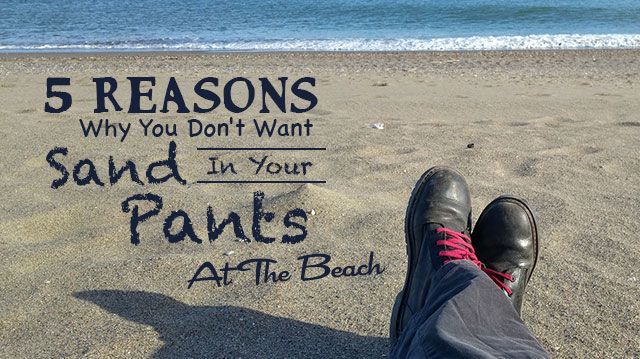
There’s nothing quite like the moment you step onto a sandy beach — the sun on your face, the breeze in your hair, the sand between your toes. It’s true bliss. After laying down, flipping through a magazine, you get up to take a sip of water — ugh, sand in your bathing-suit bottom.
Sand is beautiful to look at, it adds to the overall beach experience, but there’s one place it does not belong — in your pants. Not only is it uncomfortable, encouraging a rash to form, but it also can lead to a number of other complications. Here are five reasons you definitely do not want sand in your pants.
Reason #1: Carrier of bacteria
Popular beaches tend to attract millions of visitors each year, resulting in a wide range of potentially harmful bacteria. Within one study, two popular Chile beaches were examined and over 85 strains of cocci were found — mainly Staphylococcus, which is attributed to human activity.
It’s also been found that bacteria tend to decay much more slowly in beach sand in comparison to the water. Wastewater that contains bacteria quickly becomes embedded in biofilms — providing shelter for bacteria. Once dug up, finding its way into your bathing-suit pants can lead to various complications. The combination of moisture, bacteria-ridden sand and humidity, for instance, increases the risk of yeast infections among women.
Article: Beware Of These Bacteria Hot Spots!
Reason #2: Chafing and inflammation
Nothing is worse than a rash at the beach — often caused by sand rubbing along the skin. Once sand gets into your pants, it can be tough to get it out, especially when you’re on a public beach. Due to repetitive friction, skin irritation occurs, resulting in potentially painful chafing.
When left untreated, significant inflammation can occur. Also, if you scratch the affected area and break the skin, you increase your risk of infection. When encountering dreaded chafing this summer, there are some natural remedies available, including aloe vera and lavender essential oil.
Reason #3: Fecal contamination
We touched on the possibility of infection due to bacteria, but what about fecal contamination? Evidence has shown that sand does, in fact, harbor high concentrations of fecal particles. What does this mean in terms of illness risk? One study, published in the American Journal of Epidemiology, examined this relationship.
At this time, the sources of fecal microbial in beach sand are not fully understood. It’s believed that sewage in close proximity may be attributed to high levels, as well as urban runoff and animal waste. In total, this study interviewed 29,100 individuals exiting the beach, and 27,365 were interviewed 10 to 12 days later.
What they found was that individuals who dug into sand or had one’s body buried in the sand were at greater risk of enteric illness, such as diarrhea. Researchers concluded that site-specific factors are key in terms of risk and that further research needs to be conducted in order to determine these factors.
Reason #4: Exposure to contaminants and pollution
If you’re mindful about the food you eat and the personal care products you use, you may want to be aware of the potential contaminants lurking at your local beach. Within one study, published in Environmental Sciences Europe, several polycyclic aromatic hydrocarbons (PAHs) were found in two samples, taken from two different beaches.
PAHs are a group of more than one hundred different chemicals, which are released after burning oil, gasoline, coal, tobacco, wood and other organic materials. If you have these chemicals sitting in your bathing-suit pants all day on a regular basis, you could experience inflammation and irritation.
Reason #5: Nasty sea lice
Believe it or not, sea lice tend to be a very common threat to beach visitors. On both the East and West Coasts of the United States, sea lice, not to be confused with parasites that affect fish, are the larvae of jellyfish. Although they’re microscopic, they share the same stinging cells as their parents.
If you’re swimming or rolling around in the sand, these larvae can become trapped in your bathing-suit pants or even in skin crevices. If so, you will know — trust me. I was stung by a large concentration of these larvae while visiting Mexico — not pleasant.
Although most individuals experience pain, itching and blistering, some will develop more severe reactions, including nausea, fever, vomiting, chills and headaches. If you do encounter sea lice, remove your pants before jumping into the shower. Any cells sitting in your pants will release more venom when exposed to fresh water.
If you love the beach, don’t let these reasons deter you from enjoying some fun in the sun — just be aware of the potential risks in your area. Pay attention to seasonal warnings and ensure you take the proper steps to protect yourself. Leave the sand at the beach, where it belongs.
—Krista Hillis
Krista Hillis is passionate about nutrition, mental health, and sustainable practices. She has her Bachelors in Psychology and Neuroscience and is still active in her research. Studying both the body and mind, she focuses on natural health and balance. Krista enjoys writing based on her ability to inspire others and increase overall awareness.
Sources:
http://aje.oxfordjournals.org/content/170/2/164.full
http://enveurope.springeropen.com/articles/10.1186/2190-4715-23-40
http://www.cbsnews.com/news/worst-place-for-bacteria-beach-sand-water

